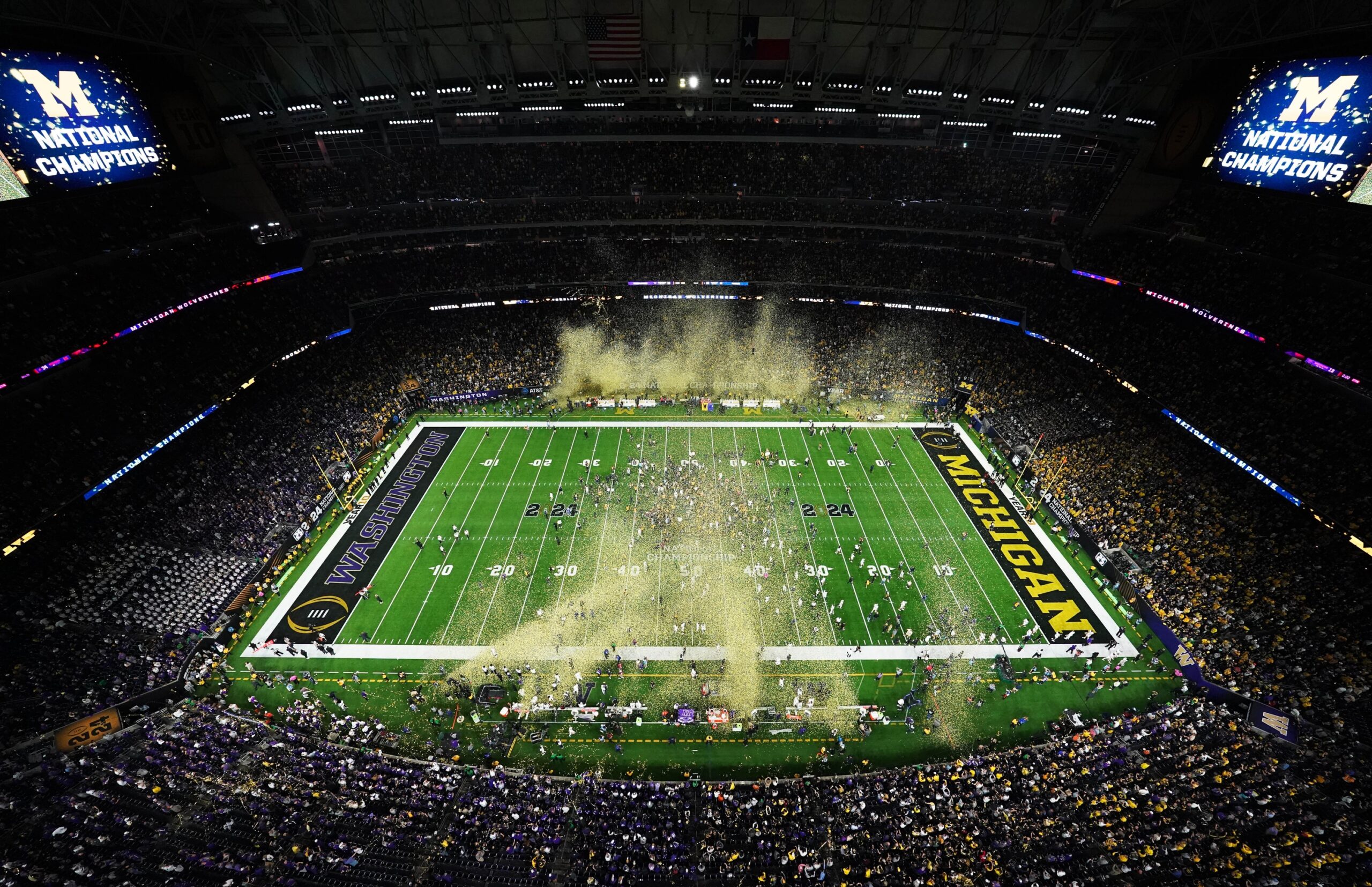The college football world is ever-changing. In less than 30 short years, we’ve gone through the Bowl Coalition, Bowl Alliance, Bowl Championship Series (BCS), a four-team College Football Playoff, and will be expanding to a 12-team College Football Playoff in 2024. And, to add to it, the CFP will expand further to 14 teams starting in 2026! Naturally, the thought process has shifted to what the next big thing will be. Enter, the College Football Super League.
College football is one of the biggest economic forces in the United States and has become more of a national brand rather than a regionally-focused commodity. It’s only natural to want to make it as good as can be. Attempting to make it so that the cream always rises to the top and replicating a Premier League-esque model only makes sense.
For decades, college football has thrived off of “what if.” Or even, “Could 2019 LSU beat 2001 Miami (FL)?” With a better College Football Super League than what has been proposed, it would make those discussions even better. Imagine a system where the bluebloods are in a division of their own, battle it out yearly, and have to keep it up with the risk of relegation.
A Better College Football Super League
Right now, college football likes to pride itself on the “any given Saturday” idea where any of the 130+ FBS programs could win a national championship. As any fan of a mid-tier Power 4 or any Group of 5 program would tell you, this is simply not true. The game of football Georgia plays is not quite the same as what Akron puts on display.
The consolidation of power has already begun and a College Football Super League would just cut to the chase. The Big 10 and SEC are locked into a nuclear arms race reminiscent of the Cold War. Meanwhile, the Big 12 is sitting there cannibalizing the remains of the Pac-12. The ACC is one judge’s decision from having its biggest brands bolt. Plus, the Group of 5 is constantly on edge, attempting to keep its best stars from transferring or top programs from getting poached.
Realistically, college football needs to be saved from itself.
The Current Proposal is Weak
A group calling itself “College Sports Tomorrow” made up of high-ranking individuals at institutions who could be left behind has come up with its own proposal. Their attempt has a framework of seven divisions of 10 including 70 of college football’s historically “best” teams. Those teams would be immune from relegation. There would be an eighth division made up of Group of 5 overachievers, essentially. It would be from that group programs would be relegated to Tier 2. Tier 2 would have 50 of the next programs and would get the opportunity to fight it out to be promoted into the consolation division.
This proposal smells like the 2008 housing crisis where the banks that caused the crash were deemed “too big to fail.” It would be the same in this College Football Super League proposal. If a program is deemed “too big to fail,” they are safe from relegation despite a one-win season.
Plain and simple, no program should be safe. If Ohio State gets rail-roaded and ends up 2-10 with their only wins coming from Group of 5 competition, they should absolutely be at risk.
Where this proposal is sound is in its CFP. Theirs has eight division champions and then the next eight best teams via Wild Cards. It throws a bone to the Group of 5 consolation division and expands the tournament to 16 teams.
All in all, College Sports Tomorrow’s proposal shows the Power 4 conferences are scared of being passed over or exposed. The name “College Football Super League” implies that the Premier League of college football should be the absolute cream of the crop and should be able to stand on its own.
Criteria for College Football’s Premier League
Criticism without a plan is just complaining. Anyone can hop on social media and call College Sports Tomorrow’s proposal trash but rarely does anyone pony up a better framework; that’s what this proposal is.
To start, there are a number of logistical issues that need ironing out. 80 schools at the top of the College Football Super League is too many. Are there 80 programs in a given year that can win the national title? No, and it would just water down the product. The purpose of this Super League is to find the dog among dogs, the cream of the crop, and the bluest of bluebloods.
Tier 1, which could be considered the Premier League of college football, would have 40 teams. Those 40 teams would be divided up geographically into four, 10-team divisions. With the nature of promotion/relegation, these divisions could vary minimally from year to year and would likely need to be slightly realigned every now and then. The most important thing: no program is immune from relegation. If Alabama and Georgia end up in the danger zone, they’re sent down. Tier 2 and Tier 3 would also sit at 40 teams each.
The New CFP
The College Football Playoff would feature 12 teams. The four division champions (by winning percentage, like the NFL) would earn byes and the next best eight programs would earn Wild Card bids. In order to prevent certain programs from getting easier passes than others, there would be uniform scheduling. Each team would have a 12-game schedule that features nine games against the other divisional programs. One of the non-conference games would be a division versus division challenge, of sorts. It could pit the West Division’s champion from the previous season against the South Division’s champion, and so on down the standings. One of the non-conference games would be against a Tier 2 foe, and the final would be a Tier 3 foe. That way, the lower-level programs can still get their payday games while getting a crack at the big boys.
The bottom eight programs would end up relegated whereas the top eight of the lower level would be promoted. For the lower tiers, their CFP would be the same. The only kicker would be whoever wins that tier’s CFP is automatically promoted, regardless of whether or not they were one of the top eight (ie, if the 9-12 seed won it all).
Selection Process
Since the idea of this proposal is to get the top programs in all of history isolated in a single Super League, standards of selection must be set. Not every current Power 4 program is among the game’s elite. Even if they are elite today, they do not have the historical backing. At the same time, historically elite programs have padded their all-time stats with wins over less-than-stellar competition. A quick glance at Winsipedia at any historically great program will show local high schools or YMCAs as opponents.
So, with that in mind, the selection of the top tier will be based not on the current win percentage, but on the all-time win percentage over current FBS teams. For the most part, the top 40 teams remain unchanged. Since James Madison technically has a 0.6667 win percentage with this new model, the stipulation of 700 FBS games must be met.
The next part is tricky. If you sort all-time win percentage versus FBS teams and exclude the four teams who do not meet the minimum game threshold, there are 13 programs without national championships. Whereas outside of this newly-established top 40, there are 15 programs with a title. If we are to create a new Premier League, we have to reward programs that have won over the course of time.
In all reality, the first grouping is about rewarding those programs. It will all level out in time with promotion/relegation.
Tier 1 (40 Schools)
| West | North | South | East |
| Arizona State | Bowling Green | Air Force | Clemson |
| BYU | Miami (OH) | Alabama | Florida |
| Colorado | Michigan | Arkansas | Florida State |
| Fresno State | Michigan State | Auburn | Georgia |
| Oregon | Minnesota | Houston | Georgia Tech |
| Stanford | Notre Dame | LSU | Miami (FL) |
| UCLA | Ohio State | Nebraska | North Carolina |
| USC | Penn State | Oklahoma | Tennessee |
| Utah | Toledo | Texas | Virginia Tech |
| Washington | Wisconsin | Texas A&M | West Virginia |
Presenting the top 40 programs in the nation in terms of winning percentage against FBS foes. Yes, those MAC and Mountain West schools earned their way. There was a consideration of excluding programs without at least one national title. Oregon and Wisconsin would have been kicked out. So, as a result, to be as close to the English Premier League, winning percentage was the go-to.
When discussing the bluebloods of college football, there are only a few. After that, it thins out. But even then, if there are teams who don’t deserve to be in Tier 1, promotion/relegation will sort it out.
There was a standard of at least 700 FBS games to be included here. You have to weed out newer programs somehow, unfortunately.
The Second Tier (40 Schools)
| West | North | South | East |
| Arizona | Ball State | Baylor | Boston College |
| Boise State | Central Michigan | Louisiana Tech | Duke |
| Cal | Cincinnati | Memphis | Marshall |
| Nevada | Illinois | Middle Tennessee State | Maryland |
| New Mexico | Iowa | Ole Miss | Navy |
| Oklahoma State | Louisville | SMU | North Carolina State |
| San Diego State | Mizzou | Southern Miss | Ohio |
| Texas Tech | Northern Illinois | TCU | Pitt |
| Tulsa | Purdue | Troy | South Carolina |
| Wyoming | Western Michigan | UCF | Syracuse |
Tier 2 gets a bit interesting with the drawing of the divisions. There are four Texas-based schools but with how it all shook out, Texas Tech was separated from the other three. In addition to the stipulation of 700 games for Tier 1, Tier 2 was cut off at 300 games.
This tier has a healthy mix of current Power 4 and Group of 5 programs. This tier would likely end up as the most competitive of the three. On one hand, it’ll feature the rejects from the top who would be hungry to get back. On the other, these 40 teams are a season away from being able to compete with the truly elite programs.
The Third Tier (40 Schools)
| West | North | South | East |
| Colorado State | Arkansas State | Appalachian State | Akron |
| Hawai’i | Indiana | ECU | Army |
| New Mexico State | Iowa State | FAU | Buffalo |
| North Texas | Kansas | Louisiana | Eastern Michigan |
| Oregon State | Kansas State | Mississippi State | Kent State |
| San Jose State | Kentucky | Rice | Rutgers |
| UNLV | Louisiana-Monroe | Tulane | Temple |
| Utah State | Northwestern | UAB | UConn |
| UTEP | Vanderbilt | USF | UMass |
| Washington State | Western Kentucky | Wake Forest | Virginia |
Finally, the third tier is a collection of the underachievers and plucky upstarts. Appalachian State actually has the 27th-best winning percentage against FBS teams but has not played nearly enough games to be considered.
The most interesting part of his tier would have to be the current Power 4 programs. Who will be the first to get sent down to Tier 4? Will any step up and dig out of the middle third of Division I?
Fourth Tier And Beyond
With the new tiers, there will be a few programs on the proverbial chopping block. Even then, the likes of Charlotte, Coastal Carolina, Florida International, Georgia Southern, Georgia State, Jacksonville State, James Madison, Kennesaw State, Liberty, Old Dominion, Sam Houston State, South Alabama, Texas State, and UTSA will be in Tier 4. Alongside the top FCS programs, they’d have the opportunity to win their way up.
In this new College Football Super League, the designations of FBS and FCS would cease to exist. The six-tiered system would go back to just being called Division I. It always was odd that college football had FBS and FCS.
Again, this new system is in a vacuum and looks at the all-time impacts of programs. The success in 2023 of Liberty and James Madison unfortunately do not outweigh the fact that they are among the newest at their current level.
Behold, The College Football Super League!
No change to how college football operates will be perfect; there will always be programs that feel slighted. However, the solution is to win. With a tiered system such as this College Football Super League, any program could be rewarded for a great season. Every Tier 2 team is a great year away from challenging for the national title.
Naturally, the scheduling at the top would be brutal. That’s the point! With a promotion/relegation system, you want the greatest of the great at the top. When the Premier League was founded in England, it was to make sure the top clubs got to contend for titles and to compete with the other European leagues like Serie A or La Liga. This proposal would make the game of college football that much better. Every program would have to try to win rather than sit back and ride the coattails of their respective conference.
In addition, when the NCAA investigates and finds rule-breaking, relegation would be a very real threat. Imagine a blueblood program was found guilty of years of cheating, for example. The NCAA, in addition to the rest of their sanctions, could kick that program down a tier or two. The punishment would be just as effective as a bowl ban.
College football is going to continue to change. The longer it pretends that it cares about tradition and regionality, the longer it will hamstring itself from being truly great. A six-tiered system such as this would do wonders for the quality of the game. It would prove without a doubt who the true champion would be.







